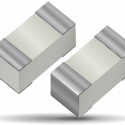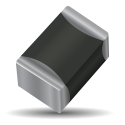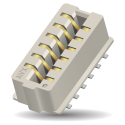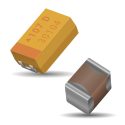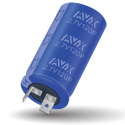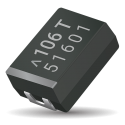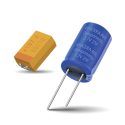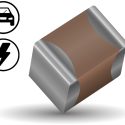Surface Mount Thermal Conductors for Heat Management Written By: Jern Ng Abstract: Efforts to miniaturize electronics are becoming increasingly common as designers work to fit more components into smaller packages, offering low-weight, low-volume products. The continuous march toward electronic miniaturization brings to light one primary challenge: the dissipation of heat. As semiconductor manufacturing realizes smaller feature sizes, microprocessor capability is simultaneously advancing with greater functionality.
Technical Articles / Whitepapers
Aluminum Electrolytic Capacitor Use in Three-Phase BLDC Motor Controllers Written By: Ron Demcko | Slavomir Pala Abstract: The uses of industrial control systems and robotics are expanding rapidly due to their positive impact on costs and quality. This paper will discuss Aluminum Electrolytic capacitor roles as an output filter capacitor to improve power quality in Brushless DC Motor (BLDC) motor controller & drives. Aluminum Electrolytic capacitors can be used to provide exacting drive voltage to motors. This in turn improves system reliability and performance. The case studied will be a 3-phase, 24V / 30 watt BLDC motor with a rated speed of 4000rpm and rated torque of 0.072 N-m.
Miniature MLVs for Advanced Driver Assistance Systems Written By: Sudhama Dharmappa Abstract: Advanced Driver Assistance Systems (ADAS) have been used to enhance vehicle safety and performance long before the pursuit of self-driving cars. Since the moment electronic sensors were integrated into automotive designs, a variety of driver assistance techniques have been widely adopted, including anti-lock braking, traction control, and cruise control.
KYOCERA AVX Card Edge Connectors For Automotive Applications Written By: Ashok Dhulgande | John McCarry Abstract: This whitepaper discusses key design considerations for electrical spring contacts and board connections and provides an overview of KYOCERA AVX’s card edge connectors for automotive applications.
Replacing Aluminum Electrolytic Capacitors with Tantalum or Ceramic Capacitors Written By: Teddy Won Abstract: Like all capacitors, electrolytics (e-caps) are based on the principle of storing energy in an electric field using a voltage applied across a dielectric. This paper discusses the basic structure and characteristics of electrolytics and shows alternates for circuit use.
Using SuperCapacitors in Electric Vehicles Written By: Adrian Thomas Abstract: The improved performance and practicality of electric vehicles (EVs) have merited them a permanent foothold in the overall automotive market. When combined with geo-political and environmental initiatives, it is clear that the demand for EVs will continue to increase long into the future.
Low ESR Tantalum Capacitors in Circuit Design Written By: Colin Li Abstract: Tantalum is a relatively scarce transition metal with several unique properties that make it a technology-critical element. It is highly corrosion-resistant and chemically inert. It is non-ferrous and non-magnetic, has a high melting point and density, and is extremely stiff. Most importantly, Tantalum readily forms a protective and electrically insulating oxide layer. This ability makes it an ideal candidate as the base building block of electrolytic capacitors.
Tantalum and SuperCapacitors Enable Maintenance Free Microcontrollers Written By: Ron Demcko | Daniel West | Ashley Stanziola Abstract: Ultra-low-power microcontroller families now exist with such low power requirements that they can be powered by energy harvesting rather than battery-operated or conventional mains. These powerful MCUs enable maintenance-free control systems in applications ranging from structure/soil/water/air monitoring applications to industrial point controllers (such as smart faucets) to wearable electronics, location tracking, and even BLE beacons.
High Voltage Ceramic Capacitors for Electric Vehicles Written By: Jeff Lee Abstract: Electric vehicles (EVs) have accelerated the demand for high-performance, high-reliability capacitor technologies. The wide array of voltage, power, and size requirements of the various electrical subsystems in modern EVs necessitates careful capacitor selection by designers. As shown in the blue segments of figure 1, these subsystems include AC-DC conversion, DCDC conversion, power management, and battery monitoring, to name a few.
Energy Storage Capacitor Technology Comparison and Selection Written By: Daniel West| Ussama Margieh Abstract: Tantalum, MLCC, and super capacitor technologies are ideal for many energy storage applications because of their high capacitance capability. These capacitors have drastically different electrical and environmental responses that are sometimes not explicit on datasheets or requires additional knowledge of the properties of materials used, to select the best solution for a given design.
Practical Capacitor Tolerance Selection for Coupling, DC Blocking and Bypass Applications Abstract: Proper selection of suitable capacitor tolerances is governed to a great extent by the type of application under consideration. This point should always be taken into account when designing for the best balance between cost and performance. For example, DC blocking, coupling and bypassing applications are not very sensitive to the variations in capacitor value that are due to the choice of wide spread tolerances. In contrast, applications such as filtering and matching will usually require narrow spread capacitance tolerances in order to meet the specific demands of those designs.
ESR Losses in Ceramic Capacitors Abstract: In the world of RF ceramic chip capacitors, Equivalent Series Resistance (ESR) is often considered to be the single most important parameter in selecting the product to fit the application. ESR, typically expressed in milliohms, is the summation of all losses resulting from dielectric (Rsd) and metal elements (Rsm) of the capacitor, (ESR = Rsd + Rsm). Assessing how these losses affect circuit performance is essential when utilizing ceramic capacitors in virtually all RF designs.
Considerations for Optimal Capacitive Coupling Abstract: Capacitors used in coupling and DC blocking applications serve to couple RF energy from one part of a circuit to another and are implemented as series elements. Proper selection of coupling capacitors insures the maximum transfer of RF energy. All capacitors will block DC by definition; however, considerations for satisfying the requirements of a coupling application depend on various frequency-dependent parameters that must be taken into account beforehand.
Capacitors in Broadband Applications Abstract: Proper selection of capacitors for RF broadband applications requires careful evaluation of frequency dependent parameters and certain design requirements. In today’s rapidly expanding RF and microwave markets, numerous designs must operate over multiple octaves of frequency spectrum. Some of the more common of these include broadband bias networks such as transistor emitter and FET source bypassing, transistor collector and FET drain feed structures, as well as interstage RF coupling, DC blocking, and wideband impedance matching.
Capacitor Pi Network for Impedance Matching Application Note 026 Abstract: Designing matching networks is one of the key aspects of RF/Microwave design. A lossless network that matches an arbitrary load to real impedance has to have at least two reactive elements. However, two elements do not give control over the bandwidth and the degree of match simultaneously. Three-element matching networks, i.e. Pi- and Teenetworks, provide additional control of the frequency response.
RF Ceramic Chip Capacitors in High RF Power Applications Abstract: In today’s world of wireless communications systems there are a myriad of high RF power applications that necessitate the use of high quality specialized ceramic chip capacitors. These demands require the designer to carefully account for factors such as device power dissipation and maximum current and voltage ratings as well as thermal resistance and temperature rise during normal circuit operation. This article highlights some of the most essential elements needed for selecting capacitor products suitable for these applications.
